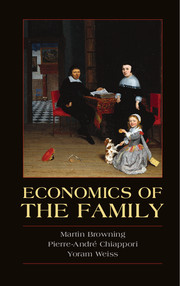Book contents
- Frontmatter
- Contents
- List of Tables
- List of Figures
- Acknowledgments
- Introduction
- PART I MODELS OF HOUSEHOLD BEHAVIOR
- 1 Facts
- 2 The Gains from Marriage
- 3 Preferences and Decision Making
- 4 The Collective Model: A Formal Analysis
- 5 Empirical Issues for the Collective Model
- 6 Uncertainty and Dynamics in the Collective Model
- PART II EQUILIBRIUM MODELS OF THE MARRIAGE MARKET
- Author Index
- Subject Index
6 - Uncertainty and Dynamics in the Collective Model
Published online by Cambridge University Press: 05 July 2014
- Frontmatter
- Contents
- List of Tables
- List of Figures
- Acknowledgments
- Introduction
- PART I MODELS OF HOUSEHOLD BEHAVIOR
- 1 Facts
- 2 The Gains from Marriage
- 3 Preferences and Decision Making
- 4 The Collective Model: A Formal Analysis
- 5 Empirical Issues for the Collective Model
- 6 Uncertainty and Dynamics in the Collective Model
- PART II EQUILIBRIUM MODELS OF THE MARRIAGE MARKET
- Author Index
- Subject Index
Summary
The models developed in the preceding chapters were essentially static and were constructed under the (implicit) assumption of perfect certainty. As discussed in Chapter 2, such a setting omits one of the most important roles of marriage – namely, helping to palliate imperfections in the insurance and credit markets by sharing various risks and more generally by transferring resources both across periods and across states of the world. Risk sharing is an important potential gain from marriage: individuals who face idiosyncratic income risk have an obvious incentive to mutually provide insurance. In practice, a risk-sharing scheme involves intrahousehold transfers that alleviate the impact of shocks affecting spouses; as a result, individual consumptions within a couple may be less responsive to idiosyncratic income shocks than they would be if the persons were single. Not only are such risk-sharing mechanisms between risk-averse agents welfare improving, but they also allow the household to invest into higher-risk, higher-return activities; as such, they also may increase total (expected) income and wealth in the long run. For instance, a spouse may be able to afford the risk involved in creating his or her own business because of the insurance implicitly offered by his or her partner's less risky income stream.
Another and closely related form of consumption smoothing stems from intrafamily credit relationship: even in the absence of a perfect credit market, a spouse can consume early a fraction of his or her future income thanks to the resources coming from his or her partner. Again, intrahousehold credit, in turn, may enable agents to take advantage of profitable investment opportunities that would be out of the reach of a single person.
- Type
- Chapter
- Information
- Economics of the Family , pp. 223 - 274Publisher: Cambridge University PressPrint publication year: 2014



